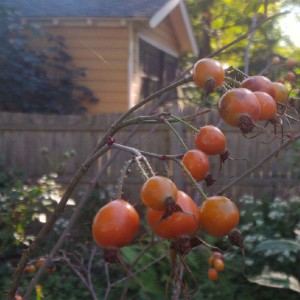 At this time of year gardeners in cold winter climates talk about “putting the garden to bed”—a series of tasks that mark the official and psychological end of the growing season. Shorter days make most of us feel like putting ourselves to bed as well, and garden chores reinforce that idea. The earth grows colder and most of us feel the need to put on warmer clothes and retreat indoors. The annuals die, spring-flowering bulbs go into the ground, and the tropical plants that have enjoyed a sunny outdoor vacation return to plant stands and windowsills. Once everything is buttoned up and put away, we and the plants can enjoy a well-deserved period of seasonal dormancy.
At this time of year gardeners in cold winter climates talk about “putting the garden to bed”—a series of tasks that mark the official and psychological end of the growing season. Shorter days make most of us feel like putting ourselves to bed as well, and garden chores reinforce that idea. The earth grows colder and most of us feel the need to put on warmer clothes and retreat indoors. The annuals die, spring-flowering bulbs go into the ground, and the tropical plants that have enjoyed a sunny outdoor vacation return to plant stands and windowsills. Once everything is buttoned up and put away, we and the plants can enjoy a well-deserved period of seasonal dormancy.
The truth is that the garden would put itself to bed even if the gardener did nothing at all. Long before anyone thought of raking or blowing leaves away, deciduous trees dropped them to the ground every autumn. Annual plants have always perpetrated one final, hopeful act, fulfilling the biological imperative and dropping seeds. Even perennials bid farewell to their top growth and take a break before coming back to life.
I have a friend who says that fall is her least favorite season. It is full of death and dying, she says, giving us nothing to look forward to except a long succession of cold, dark days. She would prefer going from September directly to March, with a brief stop in between for the winter holidays.
I think fall is a hopeful season and a good lesson for those of us who have been spoiled by all the immediate gratification offered by our fast-moving society.
I am notoriously lax about tidying the garden, and some years I do better at it than others. I tend to leave the coneflower heads in place the longest, just in case the birds need the seeds. The millions of asters, their tall stalks topped by fluffy seedheads, get cut back bit by bit, which gives them plenty of time to spread that seed around. That is, after all, how I ended up with millions of asters in the first place.
As the asters are doing their hopeful work of ensuring the survival of their species, I am filling the “holes” in my beds and borders with spring-flowering bulbs. Those bulbs already contain everything they need for spring flowering. All I provide is the right conditions—cold and darkness—that trigger the growth and flowering mechanisms. Each hole that I dig is full of promise and I know that life will be working under the soil while I decorate for the holidays, celebrate the New Year and contemplate the endless days of February—the longest short month of the year.
Those irksome leaves, that drop in the greatest numbers just after I have finished raking, will compost down, whether they do so while lurking behind the foundation shrubs or on a compost pile. I mulch many of the dry ones with my lawnmower, which sends them back to the soil more quickly. It pleases me that every time I mow, I am multi-tasking and also enriching my lawn.
I find it hopeful to prune back my collection of roses of Sharon as well. They are prolific self-seeders, and if I did nothing, I would have millions of roses of Sharon to complement my millions of asters. Since roses of Sharon are somewhat bigger, this would not be a good idea. The pruning not only stops the rose of Sharon proliferation, it helps ensure abundant flowers next year by stimulating branch growth.
I leave the rose hips in place because I know that they grow sweeter as the air grows colder. This is undoubtedly Nature’s way of providing a richer food source for hungry birds at a time when other supplies are depleted.
Successful gardeners are always a little tired at the end of the season. But tired does not mean depressed. We are seed sowers, plant tenders and bulb planters. As we put the gardens to bed, we can’t help but have hopeful dreams.
